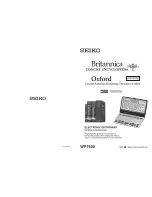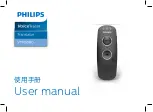
ARTURIA – ARP2600 V – USER’S MANUAL
5
1 Introduction
1.1
The birth of ARP Instruments and the ARP2600
Alan R. Pearlman, whose initials would form the name of ARP Instruments, became interested in
instruments for electronic music as early as 1948, when he was a student at the Worcester Poly-
technic Institute. This was a means for him to associate his two passions: electronic music and the
piano.
It was by commercializing the amplifier models for the NASA Gemini and Apollo programs that he
would start his career. Around 1968 he started seriously imagining the possibility of building elec-
tronic instruments – after hearing a recording of “Switched-on Bach,” according to legend.
In 1969, Alan R. Pearlman, David Friend and Lewis G. Pollock created ARP Instruments (originally
called Tonus Inc.). The company, based in Newton Highlands (Massachusetts, USA), conceived elec-
tronic products, but also and above all else a large modular synthesizer, the ARP 2500. The machine
used a matrix which connected the different sections of the synthesizer, instead of the traditional
cables found in the Moog Modulars. The ARP 2500 found success in American universities.
The growth of ARP instruments was fast and in 1972 the ARP 2600, probably the most legendary of
the entire range, was unveiled. This semi-modular synthesizer, conceived with an educational goal,
was to become hugely successful after a shaky start. The ARP 2600 was notably used by Stevie Won-
der, Joe Zawinul (Weather Report), Tony Banks (Genesis), Jean-Michel Jarre, Herbie Hancock...
ARP was the market leader in synthesizers during the 70’s with around 40% of the market share.
In ten years, three versions of the ARP 2600 were commercialized: The first version was called
“Blue meanie” because of its steely blue finish. The “blue meanie” was quickly replaced by a sec-
ond version, with a grey background finish and white silk screening (1972). This was to be more
popular. In 1978 ARP decided to change the graphic chart for all of its machines: a black background
color with orange silk screening was introduced. The ARP2600 benefited from its third and last ver-
sion.
The great rival of ARP was Moog Music. The competition between the two manufacturers can easily
be seen when we observe the machines: The ARP, for example, has linear potentiometers, while the
Moog has rotating pitch bend and modulation wheels.
A well known episode of this competition was the 24 dB/octave filter, the 4012, used by the ARP.
This was a replica of the famous Moog filter. In 1973, Moog threatened ARP with legal action and
the firm decided to change the circuits on its filter. The 4072 was born and took the place of the
4012. This possessed a calibration error in the high frequencies – the maximum cut-off frequency
was less than 11 kHz instead of the 16 kHz promised in the press. Luckily the repair for users was
fast and not much of a burden. On the first ARP 2600’s, the 4012 filter was still used (this was the
case for the “Blue meanie” and on the first examples of the “grey and white”) while the models
that followed offered the 4072.
The ARP synthesizers possess very stable oscillators, more reliable than the Moog synthesizers (a
fact admitted by Robert Moog himself). On the other hand, ARP for a long time dipped the elec-
tronic circuits for filtering in resin to avoid industrial piracy... this made for major problems when
trying to perform a repair.
In 1972, ARP launched the Odyssey, which would be in direct competition with Moog Music and their
Minimoog released one year earlier. The same year, the Pro-Soloist, a preset instrument, was also
unveiled.
In 1976, ARP released a small 16 step sequencer in the form of 2 independent 8 step sequences.
This became famous and is still very sought after (it is emulated in the ARP2600 V.) The same year
they presented the Omni, which would become one of ARPs biggest successes. The instrument al-
lowed the combination of two polyphonic violin sounds – a great innovation for the company – and 2
monophonic bass sounds.
In 1976, ARP released a small 16-step sequencer in the form of two independent 8-step sequences.
This became famous and is still very sought after (it is emulated in the ARP2600 V.) The same year
Summary of Contents for ARP2600 V
Page 1: ...USER S MANUAL ARP2600 V...
Page 5: ......
Page 6: ......
Page 26: ...24 ARTURIA ARP2600 V USER S MANUAL...
Page 36: ...34 ARTURIA ARP2600 V USER S MANUAL...
Page 94: ...92 ARTURIA ARP2600 V USER S MANUAL Selecting the AR2600 V Efx...








































